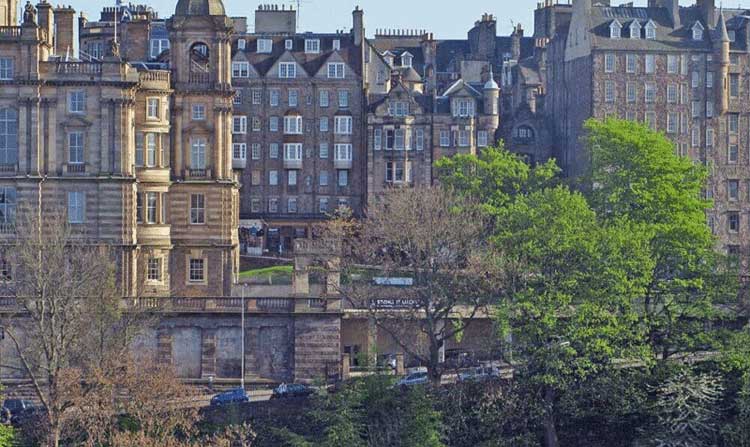
Edinburgh events during the 1600s
From the devastating scourge of the bubonic plague to significant architectural advancements and political and social upheavals, Edinburgh underwent a period of intense change.
Although each 17th century event in Edinburgh is listed separately, some of them are interconnected. Together they are designed to encourage the reader to find out more.
Each entry has a link to further information on Truly Edinburgh or other authoritative source.
1) Gladstone’s land built (1620 )
Gladstone’s Land, today a fully restored Edinburgh National Trust for Scotland (NTS) property, was built in 1620 by prosperous merchant Thomas Gledstanes.
Sited on the Royal Mile between Edinburgh Castle and the Palace of Holyroodhouse, it’s a remarkable example of early 17th-century architecture in Edinburgh’s Old Town.
This six-storey tenement building, originally serving as both a residence and a place of business.
It displays intricate wooden beams and detailed ceiling paintings that have been meticulously preserved over the centuries.
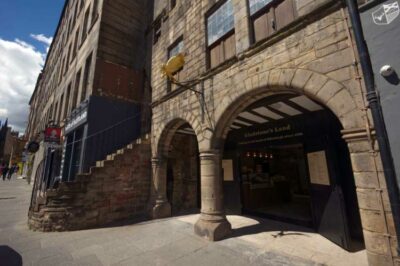
The building’s ground-floor cafe provides a welcome retreat from the bustling Royal Mile.
- More information about Gladstone’s Land from Truly Edinburgh.
2) Lady Stair’s House built (1622)
Lady Stair’s House, built in 1622, is situated in Lady Stair’s Close just off the Lawnmarket, part of the Royal Mile.
It was originally called Lady Gray’s House, named after the widow of the first owner, Sir William Gray of Pittendrum a prosperous Edinburgh merchant.
The lintel above the door is inscribed with the date 1622, and the inscription below:
“FEARE THE LORD AND DEPART FROM EVILL”
Unknown
Named after the Countess of Stair, widow of John Dalrymple, 1st Earl of Stair who lived there in the early part of the 18th century, the house is a testament to the craftsmanship of the era.
It showcases intricately carved stonework, decorative timbers and a distinctive steep roofline.
The University of Edinburgh described it as, “a three storey house with a corner stair tower and ogee roof. Inside. the hall is of mediaeval style…”
Today, it houses the Writers’ Museum which celebrates the lives and works of Scotland’s literary greats, including Robert Burns, Sir Walter Scott, and Robert Louis Stevenson.
- More information about the Writers’ Museum from Museums and Galleries Edinburgh.
3) George Heriot died (1624)
George Heriot (Jingling Geordie), born in Edinburgh in 1563, was a renowned Scottish goldsmith and philanthropist. He died on February 12, 1624, in London.
With the help of his influential father, also a goldsmith, he set up his first business in a tiny workshop that stood against the walls of St Giles’ Cathedral. He was only 23 years old.
Heriot was best known for his role as the court goldsmith to the court of King James VI of Scotland and his wife Anne of Denmark who often asked him for money. It was a relationship that brought him considerable wealth.
“Gordg Heriatt, I ernestlie dissyr youe send me tua hundrethe pundes…”
Anne of Denmark
However, his most enduring legacy lies in his philanthropic endeavours, particularly the founding of a “Hospital and school for the education, nursing and upbringing of poor orphans…” now known as George Heriot’s School.
- More information about George Heriot from Truly Edinburgh.
4) The Founding of the Royal Botanic Garden Edinburgh (1670)
The Royal Botanic Garden Edinburgh (RBGE) was founded in 1670 by Sir Andrew Balfour and Sir Robert Sibbald, two prominent Scottish physicians.
Initially established as a physic garden near Holyrood Abbey, its primary purpose was to cultivate medicinal plants for the study and treatment of illnesses. The garden quickly grew in both size and reputation, becoming a vital resource for the study of botany and medicine in Scotland.
In 1820, it moved to its current location in Inverleith, where it continues to thrive as a major attraction for visitors and researchers. The garden’s rich history and ongoing contributions to the field of botany make it an essential part of Edinburgh’s cultural and scientific heritage.
Its mission statement is, “to explore, conserve and explain the world of plants for a better future.”
- More information about the Royal Botanic Garden Edinburgh (RGBE) from Truly Edinburgh.
5) Riot in St Giles’ Cathedral (1637)
The 1637 riots at St Giles Cathedral in Edinburgh were sparked by King Charles I’s attempt to impose a new Anglican prayer book on the Scottish Presbyterian Church.
A woman, who may have been a local stallholder called Jenny Geddes, protested against this religious imposition by throwing a stool at the preacher.
Her actions starting a riot that spread throughout the city and further afield.
“Daur ye say mass in my lug”
Jenny Geddes (legend)
The riot at St. Giles’ Cathedral had significant repercussions, as it marked the beginning of widespread resistance to Charles I’s religious reforms. This event, with others, is often seen as a precursor to the Wars of the Three Kingdoms (English Civil Wars).
Jenny Geddes’ act of defiance became a symbol of Scottish resistance and the struggle for religious and political autonomy. Her legacy is commemorated in various ways, including a plaque in St. Giles’ Cathedral, ensuring that her contribution to Scottish history is remembered.
6) National Covenant signed in Greyfriars Kirk (1638)
On February 28, 1638, the National Covenant was signed at Greyfriars Kirk in Edinburgh. This declaration was a response to King Charles I’s attempts to impose Anglican practices on the Presbyterian Church of Scotland, asserting the Scots’ right to religious and civil freedoms.
Over 300,000 Scots signed the Covenant, uniting against the king’s reforms.
This pivotal event, together with others, led to the Bishops’ Wars and the Wars of the Three Kingdoms, highlighting the Covenanters’ crucial role in the struggle for autonomy.
7 The Plague of 1645-46 and Mary King’s Close
Although the plague had often visited the city, the Great Plague of 1645, devastated Edinburgh, spreading rapidly in the overcrowded and unsanitary conditions of the Old Town.
The people in Mary King’s Close, known previously as as John Towris Close and Livingstoun’s Close, suffered badly.
With its cramped spaces and poor hygiene it was hit particularly hard, leading to a high death toll and quarantine measures.
The plague’s impact extended across the Old Town, resulting in mass burials and harsh containment efforts. John Paulitious was the city’s first plague doctor, followed swiftly after his death from the plague by George Ray.
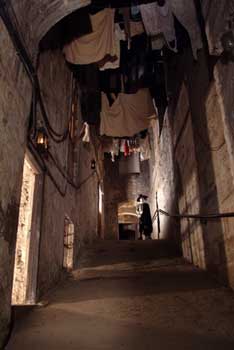
Mary King’s Close
Today, Mary King’s Close is a reminder of this dark chapter in the city’s history, drawing visitors to learn about Edinburgh’s resilience in the face of such adversity.
8) Oliver Cromwell in Edinburgh (1648 & 1650)
Oliver Cromwell’s name appears a number of times in Edinburgh’s mid-seventeen century history.
Dr Peter Gaunt from the Cromwell Association believes that Oliver Cromwell lodged in what became Moray House in the Canongate, today part of the Royal Mile, in October 1648.
Dr Gaunt said, “near contemporary references and strong tradition alike place him at Moray House.”
After his victory at the Battle of Dunbar in September 1650, Cromwell’s forces marched into Edinburgh, taking control of the city and its strategic stronghold turning the Great Hall into a barracks.
In what is today the west end of Edinburgh, Cromwell also stationed his troops and horses in St Cuthbert’s Parish Church, a historic place of worship, named after 7th century St Cuthbert.
Because of its location it is often referred to as the “Church beneath the Castle of Edinburgh.” Scholars believe it to be one of the oldest Christian sites in the city.
- More information from the Cromwell Association about the Canongate House.
- More information about St Cuthbert’s Parish Church from Truly Edinburgh.
9) James Graham, the 1st Marquis of Montrose executed in Edinburgh (1650)
James Graham, the 1st Marquis of Montrose, was executed at the Mercat Cross in Edinburgh on May 21, 1650.
Montrose, a prominent Royalist military leader, had initially supported the Covenanters but later sided with King Charles I during the Wars of the Three Kingdoms.
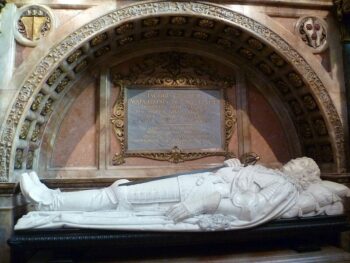
After a series of military successes, he was eventually defeated by a Covenantor army under the command of David Leslie at the Battle of Philiphaugh in 1645. His execution marked the end of a dramatic and tumultuous life.
10) Bank of Scotland established (1695)
The Bank of Scotland was founded on July 17, 1695, under the authority of an Act of the Scottish Parliament.
It was the first bank to be established in Scotland, with the aim of developing Scotland’s trade with other countries and creating a stable banking system.
In order to raise the necessary capital, a subscription book was opened at the Cross Keys Tavern in Edinburgh. The Marquis of Tweeddale, Lord High Commissioner of Scotland became the first subscriber or Adventurer, as they became known.
It was a significant event in Scottish economic history, but it also led to considerable turmoil and rivalry with other institutions.
- More information about the founding of the Bank of Scotland and later the Royal Bank of Scotland from Truly Edinburgh.
11) Ships leave Leith for Darien (1698)
In 1698, ships left the port of Leith bound for Darien Gap in what is now modern Panama. The organisers had planned to establish a trading post with overland route to connect the Pacific and Atlantic Oceans.
The venture was driven by economic desperation and the desire to improve Scotland’s financial situation, which had been severely affected by years of warfare and famine.
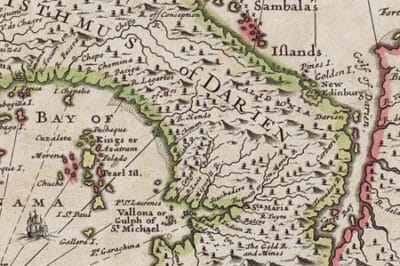
A second expedition left Scotland in the following year only to find the trading post abandoned.
The failure of the Darien Scheme as it became known, was a financial disaster for Scotland and had a huge effect on the 1707 Act of Union negotiations.
The business established by act of parliament in June 1695 to manage the Darien Scheme was called The Company of Scotland Trading to Africa and the Indies.
- More information about the Darien Scheme from Truly Edinburgh.
- More information about The Company of Scotland Trading to Africa and the Indies from the National Archives of Scotland.
17th century events in Edinburgh: conclusion
Edinburgh underwent a profound transformation in the 17th century, influenced by pivotal events that played a crucial role in shaping the city’s identity and future.
Four centuries later, the legacy of this turbulent century is still evident in the city’s extensive historical legacy.
17th century events in Edinburgh: suggestions for further research & reading
- Makey, W., 2021. Edinburgh in mid-seventeenth century. In The Early Modern Town in Scotland (pp. 192-218). Routledge.
- Dingwall, H., 1999. 130-The Power Behind the Merchant? Women and the Economy in Late-Seventeenth Century Edinburgh.
- Coghill, H., 2014. Lost Edinburgh: Edinburgh’s Lost Architectural Heritage. Birlinn.